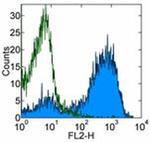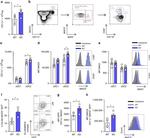Search Thermo Fisher Scientific
Invitrogen
Ea52-68 peptide bound to I-Ab Monoclonal Antibody (eBioY-Ae (YAe, Y-Ae)), eBioscience™
FIGURE: 1 / 2
Ea52-68 peptide bound to I-Ab Antibody (14-5741-82) in Flow


Product Details
14-5741-82
Species Reactivity
Published species
Host/Isotype
Class
Type
Clone
Conjugate
Form
Concentration
Purification
Storage buffer
Contains
Storage conditions
Shipping conditions
RRID
Product Specific Information
Description: The Y-Ae antibody reacts with a class II major histocompatibility complex (MHC) self Ea peptide (peptide 52-68) bound to I-Ab molecules. The Y-Ae antibody detects a determinant expressed on a subset of class II I-Ab molecules in strains that also express class II I-Eb. This determinant is expressed on peripheral B cells and on cells in the thymic medulla, but not thymic cortical epithelium. In addition to B cells, the Y-Ae determinant is expressed at comparable levels on other antigen presenting cells, including macrophages and dendritic cells. The antibody does not react with invariant chain-associated class II MHC complexes.
The reactivity of the Y-Ae antibody is MHC-restricted. The Y-Ae antibody was generated by immunization of [B10.MBR x B10.D2]F1 recipients with B10A(5R) LPS blasts. In this strain combination, there is incompatibility for I-Ab and I-Eb molecules. The antibody reacts with 10-15% of surface I-Ab molecules in strains that also express surface I-Eb molecules (e.g., strains B10.A(5R) and B10.A(3R)). The antibody does not react with I-A molecules in strains that have a non-functional I-E (a chain) gene (e.g., strains B6 and B10), nor with mutant I-A molecules (e.g., (B6.c-H-2bm-12 x A.TFR5)F1), nor with any other strain tested. The Y-Ae antibody recognizes an Ea peptide (Ea 52-68) bound to I-Ab molecules, but not to Ea 52-68 peptide bound to I-Ak or I-Abm-12 molecules.
Applications Reported: This eBioY-Ae (YAe, Y-Ae) antibody has been reported for use in flow cytometric analysis.
Applications Tested: This eBioY-Ae (YAe, Y-Ae) antibody has been tested by flow cytometric analysis of a mouse strain known to express the I-A(b)/MHC Class II:Ea peptide complex. This can be used at less than or equal to 0.5 µg per test. A test is defined as the amount (µg) of antibody that will stain a cell sample in a final volume of 100 µL. Cell number should be determined empirically but can range from 10^5 to 10^8 cells/test. It is recommended that the antibody be carefully titrated for optimal performance in the assay of interest.
Purity: Greater than 90%, as determined by SDS-PAGE.
Aggregation: Less than 10%, as determined by HPLC.
Filtration: 0.2 µm post-manufacturing filtered.
Target Information
MHC class II molecules are heterodimers of non-covalently associated alpha (31-34 kDa) and beta (26-29 kDa) chains. Major histocompatibility complex class II antigen presentation requires the participation of lysosomal proteases in two convergent processes. First, the antigens endocytosed by the antigen presenting cells must be broken down into antigenic peptides. Second, class II molecules are synthesized with their peptide-binding site blocked by invariant chain (Ii), and they aquire the capacity to bind antigens only after Ii has been degraded in the compartments where peptides reside. MHC class II molecules present exogenously derived antigen to CD4+ T lymphocytes, which are usually T helper cells. CD4 interacts with non-polymorphic residues of MHC class II.
HLA and MHC antibodies play a significant role in Immunopeptidomics, facilitating the identification and characterization of neoantigens through high-performance liquid chromatography coupled to tandem Mass Spectrometry.
For Research Use Only. Not for use in diagnostic procedures. Not for resale without express authorization.
Bioinformatics
Protein Aliases: H-2 class II histocompatibility antigen, A beta chain; H-2Eb; H2Eb; histocompatibility 2, class II antigen A, beta 1; Ia-4; Ia4; major histocompatibility complex class II beta chain; MGC163794; MGC163796; MHC class II antigen A beta; MHC class II H2-IA-beta-psi; response to metastatic cancers 1
Gene Aliases: Abeta; AI845868; H-2Ab; H2-Ab; H2-Ab1; H2-iabeta; I-Abeta; Ia-2; Ia2; IAb; Rmcs1
UniProt ID: (Mouse) P14483
Entrez Gene ID: (Mouse) 14961

Performance Guarantee
If an Invitrogen™ antibody doesn't perform as described on our website or datasheet,we'll replace the product at no cost to you, or provide you with a credit for a future purchase.*
Learn more
We're here to help
Get expert recommendations for common problems or connect directly with an on staff expert for technical assistance related to applications, equipment and general product use.
Contact tech support
